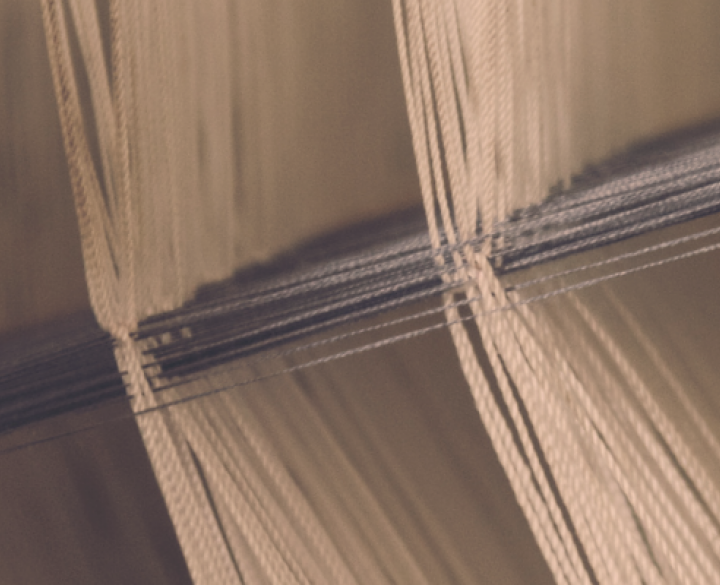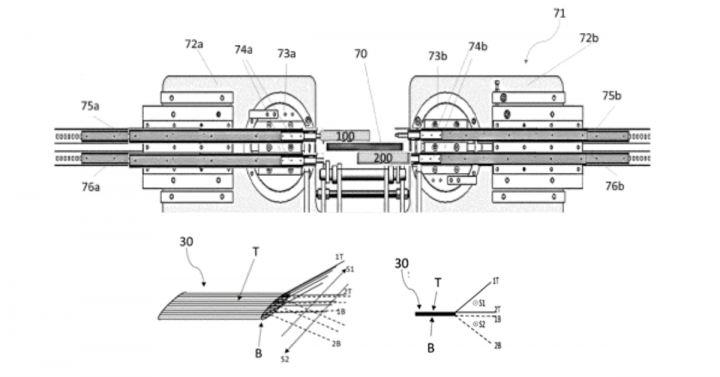Applicant: QMATEX
Inventors: Henk LAMBRECHT, Martijn DECLERCQ
Patent application number: EP4108819 A1
The problem
Fabrics consist of a cross between warp threads and weft threads. In weaving machines or looms, the warp threads come from individual bobbins or from a weaving beam and are moved up and down to form a shed or sheds by a shedding mechanism. A weft thread is inserted between the warp threads in between each up and down movement of the warp threads and a reed is actioned to push the inserted weft thread against the weaving line or beating up point, before a new up-down movement of the warp threads to make a further shed.
There are several ways to insert a weft thread between the warp threads, such as with a gripper, a rapier, a projectile, air- or water insertion means depending on the type of weaving machines. The weft thread 10 on one side of the fabric is taken by a gripper and brought to the other side of the fabric. A reed pushes the threads up to the fabric line, the weft threads being interlaced with the warp threads 11 so that the weft is compacted. After that, the weft thread is cut, and a new weft thread is inserted. This principle is valid for gripper-, rapier, projectile, air- or water weaving machines. The weft thread is interrupted (cut) each time. An example of such gripper weaving machine is described in EP0109607A1. A projectile moves through the shed and inserts a weft thread. The projectile is then transported back without a weft thread on a different trajectory not extending through a shed. This involves that it is impossible to make seamless closed-edge multilayer fabrics.
When weaving, some of the warp threads in a shed are in an up position and some are in a down position when the shuttle crosses them. At the next weft insertion, the warp threads in the up position are moved to the down position and the ones in the down position are moved to the up position. When a Jacquard is used, more complex operations of the warp and weft threads are possible. In the description below, weaving works refer to simple weavings.
A modification of the basic technique described above allows to weave tubular or multilayer (for example semi-tubular) seamless fabrics. To weave such tubular fabric, the tube is constructed from two superimposed layers of fabric, a top layer and a bottom layer. For implementing the tube with one layer of weft thread, in a first move, the shuttle passes through the shed of the warp threads of the top layer, the shed being formed by half the top warp thread being in an up-position, the other top warp threads in a bottom position, along with all the bottom warp threads of the bottom layer. After this first pick, all the warp thread of the top layer are moved to the up-position, along with half the bottom warp threads of the bottom layer i.e. half of all the bottom warp threads move upward to form a further shed, and the shuttle passes, in the other direction, through this warp thread shed of the bottom layer. The weft thread from the shuttle has then accomplished a rotation of the weft yarn.
This principle has mainly two disadvantages. Firstly, it is necessary to move the shuttle successively in both directions to weave a full revolution. Two weaving picks are necessary to complete one cycle or one full revolution. Secondly, many threads are moved up and down at every passage of the shuttle, thereby possibly creating friction and deterioration of the threads. The detrimental effect of friction does not allow to weave with delicate yarns and/or high density of warp threads, as can be required for medical application. For example, tubular fabrics can be used for manufacturing stents for inserting into the lumen of an anatomic vessel. Knitted fabrics have been used but a further coating is needed on the fabric to compensate for the low density of fibers to reach the expected performance of blood impermeability. Compared to knitting, weaving allows to produce much denser fabrics. However, for such applications, the yarns must be made from small filaments, that tend to degrade easily and protrude from the yarn upon repeated frictional rubbing, making the tubular fabric not compliant for such medical applications. The applicant has therefore judged necessary to develop a new process for weaving tubular textiles to minimize the friction between yarn and optimize the weaving efficiency.
The solution
The invention relates to the field of closed edge multilayer fabrics woven on a shuttle loom, especially seamless tubular fabrics in which a weft goes in an uninterrupted way from left to right and back. It discloses a method particularly suited to weave high density tubular fabrics with fragile fibers, for example to manufacture high quality tubular fabrics for medical applications.
The invention relates to a loom and a method for weaving multilayer or tubular fabrics. The loom is arranged such that a shuttle for inserting a weft thread in between warp threads can operate a right and a left translation along two distinct lines. The shuttle thereby describes a circular movement, the warp threads are spread over three lines, thereby minimizing the friction between threads during the operations. The loom comprises means to displace the shuttle from one operating line to the other, by either rotating or translating the shuttle. To improve the production, two shuttles can operate at the same time.
To this purpose, in one aspect, the present invention relates to a loom for weaving multilayer fabrics, wherein a shuttle carrying a shuttle spool with weft thread for inserting a weft thread in between warp threads is arranged to operate a right and a left translation along a first operating trajectory or line extending between the warp threads through a first shed and a second operating trajectory or line, distinct from the first operating trajectory, extending between the warp threads through a second shed. The shuttle thereby describes a circular movement. The two operating trajectories or lines are preferably parallel.
A multilayer fabric designs a weaving work where at least two layers are manufactured simultaneously, possibly linked to each other while weaving. Preferably, the multilayer is a bi-layer fabric. In particular, a multilayer fabric can be a tubular weaving work, i.e., two superimposed layers connected along each side of the weaving work. The invention does not relate to double cloth construction where two separate fabrics, are woven in the loom at the same time, one on top of each other, one on each operating line, but to the weaving of a single fabric that can have a specific arrangement with several layers in the weaving construction in order to confer the fabric a three-dimensional structure once finished.
Contrary to classical looms where the warp threads are either in an up- or in a down-position, the loom of the invention allows to position the warp threads of a shed either in an up-position, a down-position or a median position, one of the operating trajectories or lines of the shuttle extending through a shed, i.e. between the threads in the up-position and the threads in the median position, the other operating trajectory or line of the shuttle extending through another shed, i.e. between the warp threads in the median position and the threads in the down-position.
Typically, the multilayer fabric is still decomposed in a top layer and in a bottom layer as a result of the weaving steps. The warp thread of the half of the tubular fabric (the top layer) can alternatively be positioned in an up- or in a median-position, while the warp thread of the other half (bottom layer) can alternatively be positioned in a median- or in a down-position. This arrangement involves much less thread crossing and limits the deterioration due to the friction caused by these thread crossings.
To further increase the efficiency of the weaving process, advantageously, the loom comprises two shuttles, arranged for operating a right and a left translation along the two distinct parallel lines. This is allowed by the fact that each of the right and the left movements are not happening on the same line, but rather each shuttles follows a circular path. One of the parallel lines is for a right translation while the other parallel line is for the left translation.
Advantages
Firstly, it is necessary to move the shuttle successively in both directions to weave a full revolution. Two weaving picks are necessary to complete one cycle or one full revolution.
To further increase the efficiency of the weaving process, advantageously, the loom comprises two shuttles, arranged for operating a right and a left translation along the two distinct parallel lines.





